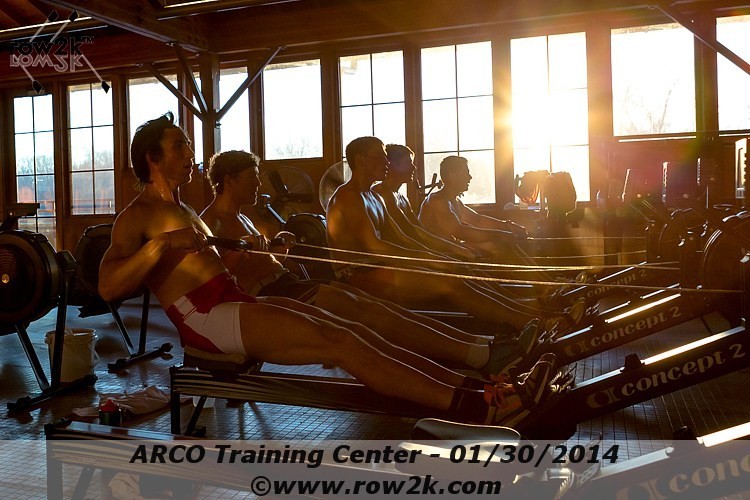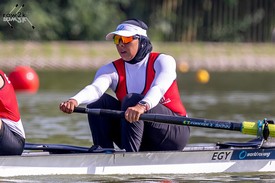
With winter descending, most of us are heading indoors to the erg. We all know it's a great training device, but it can also be a helpful tool for improving technique. Erging is a simplified version of rowing - no blades to worry about, no wind or chop to offset your balance, no steering necessary, no one to follow - just sit down and row - but don't let your erging become mindless.
Hand levels, rhythm and relaxation, body preparation and horizontal rowing can all be improved with time on the erg. Our goal here is to show how erging can make you faster on the water and not about how to have a fast erg. The erg measures power, and while we need power to row fast, we also need to apply that power efficiently. There are many different ergs out there, some let you practice your balance, others your grip or nesting but the majority of us are using the Concept2 erg. While it may be more basic than some, there is still a lot of technique work that can be done with it.
If you have trouble with balance in the single or any small boat, chances are your hand levels are inconsistent, or perhaps your body is not staying over the keel (if sculling). Set up mirrors both in front and to the side of the erg. Check your body position, particularly with the mirror in front to make sure you're not tilting your head or body or letting one leg lean out more than the other. Watch your hands and keep them level, follow the chain straight in and straight out. Muscle memory here can and will carry over into the boat.
Relaxation can be difficult to find in a single but much easier on the erg without having to worry about flipping. Ultimately, we want to use only the muscles that make the boat go faster. If your forearms or traps are tight and sore after rowing, either on the erg or on the water, you're wasting energy on muscles that are much less effective at moving the boat. Try to relax the grip, easier to do on a stable erg vs. the boat.
Relax your elbows on the drive so you connect to the lats. If your arms are locked, the tension goes up into the traps. Imagine hanging from a pull up bar - your arms are extended but not locked, just like they should be on the erg. Keep the power below the oar handle, using your quads, hamstrings, glutes, low back and lats, all big strong muscles that connect to and make up the core.

If you're not a natural stroke, finding and setting a rhythm can be difficult. We're not big fans of sticking to a pre-determined stroke rate, but prefer finding the stroke rate that works best for each specific workout. Having the monitor directly in front of you will help you keep your stroke rates consistent while the splits will help you learn what stroke rate is the most efficient for you. Play around with different rates within a set workout, say 4 x 5 minutes. Are you stronger at a lower rate or do you find yourself getting better results with a higher rate? Adjust the damper setting to find out what drag factor works best for you as well.
You also want to work on fluidity throughout the stroke, aiming for no radical change in speed during the stroke. We use the conveyor belt as an analogy: no starting, stopping, speeding up or slowing down, just a steady, continuous speed throughout. When you no longer have tension on the chain, you are done with the drive, and therefore should be on the recovery. Your toes are strapped in to help roll your body out of bow using your lower abdominal muscles. It's easy to get in the habit of pausing at the finish, taking a little breather perhaps, but every action has an equal and opposite reaction. We are looking for the body and hands to come together out of bow as we release the blade from the water. While you might not see a huge benefit on the erg, accomplishing this in the boat will help accelerate the boat underneath you. Your body moving to the stern will move the boat in the opposite direction, towards the finish line.

With the mirrors, check your body movement during the stroke. If you have a tendency to dive at the catch, work on early body preparation out of bow, getting full body prep by half slide and then keeping your body still from half slide into the catch. You could also spend some time rowing half slide with full body angle or rowing with a pause at half slide, all the time watching the mirrors. Keeping the body still into the catch is more efficient and can help with the balance.

It's very easy on the erg to work on the idea of horizontal power application. Remember that water is flat so reducing any vertical movement will be beneficial. With the mirrors, pay attention to the level of your head and shoulders, you want them to stay consistent throughout the stroke. Your head shouldn't be higher in the middle of the drive than it is at either the catch or finish position.
If the mirrors don't work for you or if you want to go a step further in this direction, try placing a camera directly next to the erg and then hooking that up to a TV or monitor placed in front of the erg. Now you can watch yourself rowing in real time. Do you break your arms too early on the drive? (Try to get the legs down before the arms begin to pull.) Get too little layback? (See how far back you can go without the head going down.) Overcompress at the catch? These and many other habits can be improved while on the erg.

Practice doesn't make perfect, perfect practice makes perfect. What you do on the erg will translate to the boat, the good and the bad, so make sure those thousands of meters on the erg are accomplished with good fluid, efficient rowing technique that you can transfer to the boat come spring. Row the erg for fitness but remember that the ultimate goal (at least for most of us) is to be faster on the water. Use the erg as a means to that end, not the end itself.
If you enjoy and rely on row2k, we need your help to be able to keep doing all this. Though row2k sometimes looks like a big, outside-funded operation, it mainly runs on enthusiasm and grit. Help us keep it coming, thank you! Learn more.
Comments | Log in to comment |
There are no Comments yet
| |
- Bont Rowing
- Calm Waters Rowing
- Concept 2
- Craftsbury Sculling
- The Crew Classic
- CrewLAB
- Croker
- Durham Boat Co.
- Empacher
- Faster Masters
- Filippi
- Fluidesign
- h2row.net
- HUDSON
- Live2Row Studios
- Nielsen-Kellerman
- Oak Ridge RA
- Peinert Boat Works
- Pocock Racing Shells
- Race1 USA
- RowKraft
- Rubini Jewelers
- Vespoli USA
- WinTech Racing
- Bont Rowing
- Calm Waters Rowing
- Concept 2
- Craftsbury Sculling
- The Crew Classic
- CrewLAB
- Croker
- Durham Boat Co.
- Empacher
- Faster Masters
- Filippi
- Fluidesign
- h2row.net
- HUDSON
- Live2Row Studios
- Nielsen-Kellerman
- Oak Ridge RA
- Peinert Boat Works
- Pocock Racing Shells
- Race1 USA
- RowKraft
- Rubini Jewelers
- Vespoli USA
- WinTech Racing

















